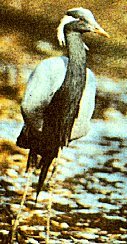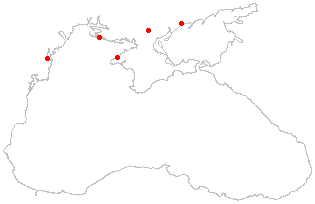 Synonyms: Grus
virgo, Ardea virgo Linnaeus, 1758
Synonyms: Grus
virgo, Ardea virgo Linnaeus, 1758Anthropoides virgo Linnaeus, 1758
 Synonyms: Grus
virgo, Ardea virgo Linnaeus, 1758
Synonyms: Grus
virgo, Ardea virgo Linnaeus, 1758
Common names: Engl: Demoiselle Crane; Russ: Krasavka, Zhuravl'-krasavka; Turk: Telli turna; Ukr: Stepovy zhuravel'
Order: GRUIFORMES
Family: GRUIDAE
Taxonomic descriptions: In the adjusted areas along the sea coast it is estimated to be within 330-380 birds. About 120-140 pairs breed in the area; the in pre-migration period gatherings reach 1000.
 IUCN
Status:
IUCN
Status:
World level: LR
Black Sea Regional level: EN
Subregion level: VU
Distribution:
Habitats type, Critical habitats, Limiting factors: Breeds in steppe areas and cultivated fields either with low and thinned out mosaic vegetation or without any at all. In the post-breeding period occurs in shallow water-bodies (bays, estuaries, river mouths) surrounded by agricultural fields or steppe.
Biology: Breeding, summering and migratory species. Arrives by the beginning of the second third of April. The nest is a trampled down plot on the ground encircled by year old parts of plants, small stones, clods of earth, dry cattle droppings. Egg-laying starts from the beginning of the second third of April. The clutch consists of 1-2, rarely 3 eggs and is incubated for 28-29 days. The parents share their duties equally. Fledglings are observed at the end of June - beginning of July. Non-breeders associate in flocks of irregular size and move within the breeding area. In April-June they are joined by the unsuccessful breeders. In July-August these flocks move to the shallow waterbodies of the sea coast where families concentrate before departure to the wintering grounds. Autumn migration commences by mid October. Both vegetative (vegetal parts of plants, seeds) and animal (insects, molluscs) food is consumed.
Population trends: The numbers are low, but stable. Insufficient extension of the breeding range owing to the ability of breeding in agricultural fields and low-grazed pastures.
Threats: Clutch and chick losses due to the intensification of agriculture, disturbance and killing by people, increase in predation (Crows (Corvidae), Raccoon Dogs (Nyctereutes procyonoides), foxes (Vulpes vulpes), domestic dogs).
Conservation measures taken: There is no real protection. Only one pair breeds within a protected area.
Conservation measures proposed: Expansion of the protected areas for the breeding and concentration sites (Kerch and Tarkhankut peninsulas, the Sivash), limitation of grazing in the breeding sites, reduction in the predators' numbers, toughening of suppression measures prohibiting hunting and extraction of eggs, chicks and adults.
References:
Compiled by: Y.Andryushchenko